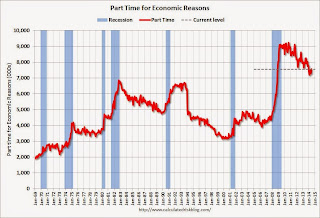by Calculated Risk on 7/03/2014 10:46:00 AM
Thursday, July 03, 2014
Comments on Employment Report
Earlier: June Employment Report: 288,000 Jobs, 6.1% Unemployment Rate
Total employment increased 288,000 from May to June, and is now 415,000 above the previous peak. Private payroll employment increased 262,000 from May to June, and private employment is now 895,000 above the previous peak (the unprecedented large number of government layoffs has held back total employment).
Through the first half of 2014, the economy has added 1,385,000 payroll jobs - up from 1,221,000 added during the same period in 2013 - even with the severe weather early this year. My expectation at the beginning of the year was the economy would add between 2.4 and 2.7 million payroll jobs this year, and that still looks about right.
Hopefully - now that the unemployment rate has fallen to 6.1% - wage growth will start to pick up.
Overall this was another solid employment report.
Employment-Population Ratio, 25 to 54 years old
 Since the overall participation rate declined recently due to cyclical (recession) and demographic (aging population, younger people staying in school) reasons, an important graph is the employment-population ratio for the key working age group: 25 to 54 years old.
Since the overall participation rate declined recently due to cyclical (recession) and demographic (aging population, younger people staying in school) reasons, an important graph is the employment-population ratio for the key working age group: 25 to 54 years old.
In the earlier period the participation rate for this group was trending up as women joined the labor force. Since the early '90s, the participation rate has mostly moved sideways (with a downward drift started around '00) - and with ups and downs related to the business cycle.
The 25 to 54 participation rate increased in June to 80.9%, and the 25 to 54 employment population ratio increased to 76.7% from 76.4%. As the recovery continues, I expect the participation rate for this group to increase.
Year-over-year Change in Employment
 This graph shows the year-over-year change in total non-farm employment since 1968.
This graph shows the year-over-year change in total non-farm employment since 1968.
In June, the year-over-year change was 2.495 million jobs, and it appears the pace of hiring is increasing.
Right now it looks possible that 2014 will be the best year since 1999 for both total nonfarm and private sector employment growth.
Part Time for Economic Reasons
 From the BLS report:
From the BLS report:
The number of persons employed part time for economic reasons (sometimes referred to as involuntary part-time workers) increased by 275,000 in June to 7.5 million. The number of involuntary part-time workers is down over the year but has shown no clear trend in recent months. These individuals were working part time because their hours had been cut back or because they were unable to find a full-time job.The number of persons working part time for economic reasons increased in June to 7.544 million from 7.269 million in May. This suggests significantly slack still in the labor market. These workers are included in the alternate measure of labor underutilization (U-6) that decreased to 12.1% in June from 12.2% in May. This is the lowest level for U-6 since October 2008.
Unemployed over 26 Weeks
 This graph shows the number of workers unemployed for 27 weeks or more.
This graph shows the number of workers unemployed for 27 weeks or more. According to the BLS, there are 3.081 million workers who have been unemployed for more than 26 weeks and still want a job. This was down from 3.374 in May. This is trending down, but is still very high. This is the lowest level for long term unemployed since February 2009.
Long term unemployment remains one of the key labor problems in the US.
State and Local Government
 This graph shows total state and government payroll employment since January 2007. State and local governments lost jobs for four straight years. (Note: Scale doesn't start at zero to better show the change.)
This graph shows total state and government payroll employment since January 2007. State and local governments lost jobs for four straight years. (Note: Scale doesn't start at zero to better show the change.) In June 2014, state and local governments added 24,000 jobs. State and local government employment is now up 138,000 from the bottom, but still 606,000 below the peak.
It is pretty clear that state and local employment is now increasing. Federal government layoffs have slowed (actually added 2,000 in June), but Federal employment is still down 23,000 for the year.


